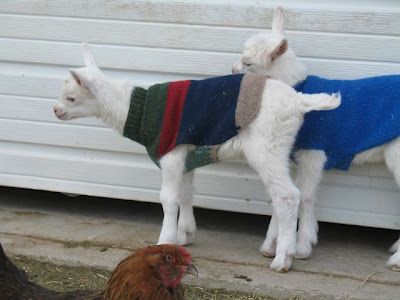It's been a long few days. Four kids were born last Monday (4/22). We dried them off and got them in sweaters like we always do.
We made sure they had their first drink of colostrum, like we always do.
Gave them each a squirt of
Nutri-Drench, like we always do.
The next day they seemed a little slow, but doing okay. Zoe is a first freshener and seemed to be a bit confused about the 2 kids at first.
Then she was okay.
Wednesday we lost one of Misty's kids. When I put Misty on the stand that night I realized she had a bad mastitis infection in her left udder.
It's been crazy since then!
The
vet came out on Thursday. She's wonderful and we love her. She gave her a shot of
Excede (a broad spectrum antibiotic) and
Banamine (for pain and inflammation).
We were given instructions to strip out her udder twice a day and warm compress the udder twice a day. Also, give
Equioxx paste (non-steroidal anti-inflamatory) twice a day to reduce the swelling in her udder, help control the pain, and help bring her 105F fever down. We also have to administer
Spectramast L C once a day into her left teat.
By Saturday night Misty was worse so I texted the vet.
Dr. Wright came out again on Sunday morning because she's that type of vet... kind and caring.
She explained that there are four main types of mastitis and she had treated for the most common, and more easily treatable, first three. Apparently Misty had the fourth type. Good thing we called.
She placed a line for IV Ringers Lactate (Misty hadn't been eating or drinking), then she started on
Baytril injectable (diluted with LRS) once daily, and Oxytetracycline injectable (LA 200) once daily.
Unfortunately she was so dehydrated that the line didn't stay in and she had to come out again on Monday and put it in the other leg.
 |
Here she is today. The only thing she will eat right now is bananas.
So that's what we are giving her! |
She seems to be doing better. We know she'll live, we're just waiting to see if she sloughs the lining of her left udder or if it heals.
Her surviving kid is doing great. She's on a bottle because the vet didn't want her on her mom. Thankfully we have Annie, who is a power milker. She's already feeding two kids, but has no trouble giving us an extra 1/2 gallon to feed the bottle kid.
I think part of the problem is that we couldn't get the mastitis vaccinations we needed last year because the company switched owners and stopped making it for a while. We didn't give them their vaccinations at the usual time. By the time I got the meds, I completely forgot about vaccinating.
All the other does have been started on their sequence of boosters and vaccinations now. Prevention is always best.
All the links to the meds are active if you are interested in looking up what they do.













































